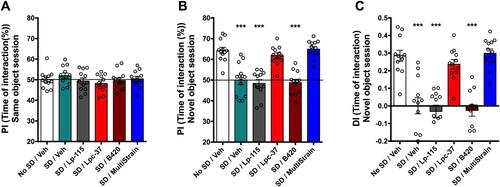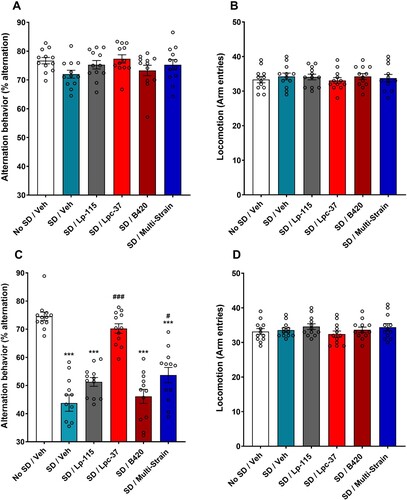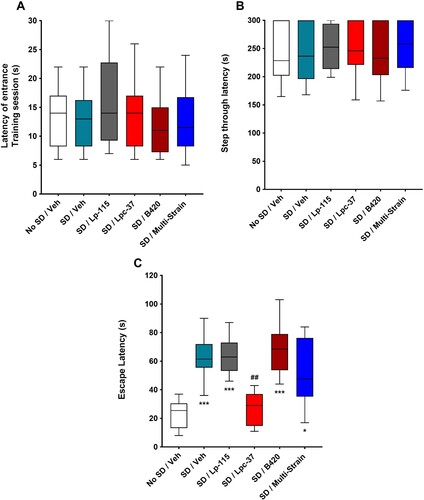Figures & data
Figure 1. Schematic diagram representing the experimental schedule and timeline of procedures during the thirty-nine days of probiotic intervention. Three individual probiotic strains and their combination were tested in mice subjected to partial SD and compared with non-SD and SD vehicle groups. Mice were administered a daily oral gavage containing either 1 × 109 colony forming units (CFU) of bacterial single-strain, 1.5 × 109 CFU of bacterial combination or vehicle for thirty days prior to and for nine days during a behavioural test paradigm. Behavioural tests were applied to evaluate learning and memory performances following a five-hour SD period before the onset of the activity phase. The behavioural tests used included the novel object recognition test (NOR; days one to three), the Y-maze spontaneous alternation test (Y-maze; days five and six) and the step-through passive avoidance task (STPA; days eight and nine), with two days of rest on days four and seven. All mice were sacrificed on day ten.

Figure 2. Effect of probiotic intervention on recognition memory deficits, induced by partial SD. (A) Preference Index (PI) expressed as the time of interaction with object in position two (% of total time of interaction) during the same object session on training day (Day 2). (B) PI for the novel object expressed as interaction time (%) during the novel object session on test day (Day 3). (C) Discrimination index (DI) calculated from the time of interaction with novel object on Day 3. All data were analysed using the one-way ANOVA and Dunnett’s test for multiple comparisons. Data are expressed as mean ± SEM. ***, p < 0.0001 vs. No SD/vehicle group.

Figure 3. Effect of probiotic intervention on spatial working memory deficits, induced by partial SD. (A and B) Alternation behaviour (%) and locomotion (arm entries) on test day 1 (Day 5), respectively. (C and D) Alternation behaviour (%) and locomotion (arm entries) on test day 2 (Day 6), respectively. (A–D) All data were analysed using the one-way ANOVA and Dunnett’s test for multiple comparisons. n = 12 for all groups. Data are expressed as mean ± SEM. ***p < 0.001 vs. No SD/vehicle group; #p < 0.05 vs. SD/vehicle group; ###p < 0.001 vs. SD/vehicle group (C).

Figure 4. Effect of probiotic intervention on contextual long-term memory deficits, induced by partial SD. (A) Latency of entrance (s) on training day (Day 8). (B) Step-through latency (s) on test day (Day 9). (C) Escape latency (s) on test day (Day 9). (A–C) All data were analysed using the Kruskal–Wallis non-parametric ANOVA and Dunn’s test for multiple comparisons. n = 12 for all groups. Data are expressed as mean ± SEM. *p < 0.05 vs. No SD/vehicle group; ***p < 0.001 vs. No SD/vehicle group; ##p < 0.01 vs. SD/vehicle group (C).

Supplemental Material
Download Zip (550.7 KB)Data availability statement
Data are available upon request from the corresponding author.
